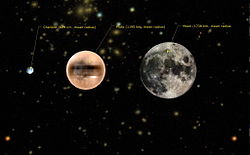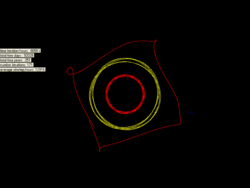- 10199 Chariklo
-
10199 Chariklo  Discovery
DiscoveryDiscovered by James V. Scotti, Spacewatch Discovery date February 15, 1997 DesignationsNamed after Chariclo Alternate name(s) 1997 CU26 Minor planet
categoryCentaur[1] Epoch November 25, 2005 (JD 2453700.0) Aphelion 18.66 AU Perihelion 13.08 AU Semi-major axis 15.87 AU Eccentricity 0.17534 Orbital period 63.17 a (23,087.2 d) Mean anomaly 10.6° Inclination 23.375° Longitude of ascending node 300.451° Argument of perihelion 242.361° Physical characteristicsDimensions 258.6 ± 10.3 km[2] Albedo 0.05-0.06[2] Spectral type B-V=0.84; V-R=0.50 Apparent magnitude ~18.3[3] Absolute magnitude (H) 6.4[1] 10199 Chariklo (pronounced /kəˈrɪkloʊ/ kə-rik-loh, /ˈkærɨkloʊ/ karr-i-kloh, or as in Greek: Χαρικλώ; provisional designation: 1997 CU26) is the largest known centaur. It orbits the Sun between Saturn and Uranus, grazing Uranus.
Chariklo was discovered by James V. Scotti of the Spacewatch program on February 15, 1997. Chariklo is named after the nymph Chariclo (Χαρικλω), the wife of Chiron and the daughter of Apollo.
A photometric study in 2001 was unable to find a definite period of rotation.[4] Infrared observations of Chariklo indicate water ice[5] on the surface.
Contents
Size
If one knows the absolute magnitude (H) and the albedo of an object one can estimate the size. But since centaurs are icy comet-like bodies that may outgas, it is very difficult to estimate their albedos. It is also likely that the albedos of some centaurs vary with time and activity levels.
With an absolute magnitude (H) of 6.4[1] and an albedo of 0.06,[2] Chariklo is currently the largest known centaur with an estimated diameter of 258 km.[2] 2060 Chiron (230 km / H=6.5 / albedo=0.07) is likely a close second.[2] Lost centaur 1995 SN55 (H=6.0) may even be the largest centaur with an estimated diameter of very close to 300 km.
Orbit
Centaurs are believed to have originated from the Kuiper belt and are in dynamically unstable orbits that will lead either to ejection from the Solar System, an impact with a planet or the Sun, or evolution into a short-period comet.[6]
The orbit of Chariklo is more stable than Nessus, Chiron, and Pholus. Chariklo lies within 0.09 AU of the 4:3 resonance of Uranus and is estimated to have a long orbital half-life of about 10.3 Myr.[7] Twenty clones of Chariklo suggest that Chariklo will not start to regularly come within 3AU (450Gm) of Uranus for about thirty thousand years.[8]
During the perihelic oppositions of 2003-4, Chariklo had an apparent magnitude of +17.7.[9] Chariklo is currently 13.7 AU from the Sun.[3]
References
- ^ a b c "JPL Small-Body Database Browser: 10199 Chariklo (1997 CU26)". 2008-07-03 last obs. http://ssd.jpl.nasa.gov/sbdb.cgi?sstr=Chariklo. Retrieved 2008-10-21.
- ^ a b c d e John Stansberry, Will Grundy, Mike Brown, Dale Cruikshank, John Spencer, David Trilling, Jean-Luc Margot (2007). "Physical Properties of Kuiper Belt and Centaur Objects: Constraints from Spitzer Space Telescope". arXiv:astro-ph/0702538 [astro-ph].
- ^ a b "AstDys (10199) Chariklo Ephemerides". Department of Mathematics, University of Pisa, Italy. http://hamilton.dm.unipi.it/astdys/index.php?pc=1.1.3.0&n=Chariklo. Retrieved 2010-02-10.
- ^ Peixinho; Doressoundiram (2000-11-09). "Photometric study of Centaurs 10199 Chariklo (1997CU26) and 1999UG5". http://aanda.u-strasbg.fr:2002/papers/aa/full/2001/20/aah2535/aah2535.html. Retrieved 2006-11-09.
- ^ Jewitt; Brown (2001-04-17). "Infrared Observations of Centaur 10119 Chariklo with possible surface variation". http://berlinadmin.dlr.de/SGF/acm2002/abstracts/pshort/16-11p.pdf. Retrieved 2006-11-09.
- ^ Scott S. Sheppard; David C. Jewitt; Chadwick A. Trujillo (2000). "A WIDE-FIELD CCD SURVEY FOR CENTAURS AND KUIPER BELT OBJECTS". The Astronomical Journal 120 (5): 2687–2694. arXiv:astro-ph/0008445. Bibcode 2000AJ....120.2687S. doi:10.1086/316805. http://www.iop.org/EJ/article/1538-3881/120/5/2687/200138.text.html. Retrieved 2008-02-21.
- ^ Horner, J.; Evans, N.W.; Bailey, M. E. (2004). "Simulations of the Population of Centaurs I: The Bulk Statistics". Monthly Notices of the Royal Astronomical Society 354 (3): 798–810. arXiv:astro-ph/0407400. Bibcode 2004MNRAS.354..798H. doi:10.1111/j.1365-2966.2004.08240.x.
- ^ "Twenty clones of Centaur 10199 Chariklo making passes within 450Gm". Archived from the original on 2009-05-13. http://home.comcast.net/~kpheider/CharClones.txt. Retrieved 2009-05-09. (Solex 10). Accessed 2009-05-10.
- ^ "AstDys (10199) Chariklo (March 2003) Ephemerides". Department of Mathematics, University of Pisa, Italy. http://hamilton.dm.unipi.it/astdys/index.php?pc=1.1.3.1&n=10199&oc=500&y0=2003&m0=3&d0=9&h0=0&mi0=0&y1=2003&m1=3&d1=20&h1=0&mi1=0&ti=1.0&tiu=days. Retrieved 2009-04-03.
External links
- 37th DPS: Albedos, Diameters (and a Density) of Kuiper Belt and Centaur Objects
- AstDys orbital elements
- Orbital simulation from JPL (Java) / Ephemeris
- Chariklo Photo (February 1999)
- Chariklo's orbit between Saturn and Uranus.
- Demonstration of how centaur 10199 Chariklo is currently controlled by Uranus (Solex 10)
Minor planets navigator Small Solar System bodies Minor planets - Designation
- Groups
- Moons
- Meanings of names
- Pronunciation of names
Comets Meteoroids Lists / categories - Asteroid groups and families
- Asteroid moons
- Binary asteroids
- Minor planets
The Solar System  Categories:
Categories:- Centaurs (minor planets)
- Asteroids named from Greek mythology
- Astronomical objects discovered in 1997
Wikimedia Foundation. 2010.

